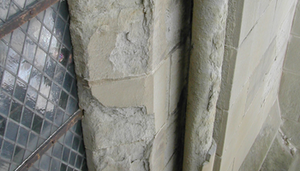
Many sedimentary stones contain clay that swells when it gets wet. The differential strain between wet and dry regions can result in deformation, stress, and cracking. The photo above shows the condition of the Cathedral of Lausanne, Switzerland, which is thought to be suffering from stress from clay in the sandstone. We are studying the mechanism of swelling and developing methods of treatment to prevent the damage.
Relevant papers:
“Hygric Swelling of Portland Brownstone”, I. Jimenez Gonzalez, M. Higgins, and G.W. Scherer, pp. 21-27 in Materials Issues in Art & Archaeology VI, MRS Symposium Proc. Vol. 712, eds. P.B. Vandiver, M. Goodway, and J.L. Mass (Materials Res. Soc., Warrendale, PA, 2002)
“Effect of swelling inhibitors on the swelling and stress relaxation of clay-bearing stones”, I. Jiménez González and G.W. Scherer, Environmental Geology 46 (2004) 364–377
“Characterization of Swelling in Clay-Bearing Stone”, G.W. Scherer and I. Jiménez González, pp. 51-61 in Stone decay and conservation, SP-390, ed. A.V. Turkington (Geological Soc. Am., 2005)
“Evaluating the potential damage to stones from wetting and drying cycles”, I. Jiménez González and G.W. Scherer, pp. 685-693 in Measuring, Monitoring and Modeling Concrete Properties, ed. M.S. Konsta-Gdoutos (Springer, Dordrecht, The Netherlands, 2006)
“Controlling stress from swelling clay”, Timothy Wangler, Angela Wylykanowitz, and G.W. Scherer, pp. 703-708 in Measuring, Monitoring and Modeling Concrete Properties, ed. M.S. Konsta-Gdoutos (Springer, Dordrecht, The Netherlands, 2006)
“Internal stress and cracking in stone and masonry”, G.W. Scherer, pp. 633-641 in Measuring, Monitoring and Modeling Concrete Properties, ed. M.S. Konsta-Gdoutos (Springer, Dordrecht, The Netherlands, 2006)
“Swelling clays and salt crystallization: Damage mechanisms and the role of consolidants”, G.W. Scherer and I. Jiménéz Gonzalez, pp. 29-39 in Proc. Int. Symp. Stone consolidation in cultural heritage, eds. J. Delgado Rodrigues and J. Manuel Mimoso (Laboratório Nacional de Engenharia Civil, Lisbon, 2008) ISBN 978-972-49-2135-8
“The role of clay minerals in the physico-mechanical deterioration of sandstone”, I. Jiménez González, C. Rodríguez-Navarro, and G.W. Scherer, J. Geological Res. 113, F02021, doi:10.1029/2007JF000845
“Clay Swelling Mechanism in Clay-Bearing Sandstones”, T. Wangler, G.W. Scherer, Env. Geo. 56 [3-4] (2008) 529-534 [DOI 10.1007/s00254-008-1380-3]
“Silicate Consolidants for Stone”, G.W. Scherer and G. S. Wheeler, Key Engineering Materials Vol. 391 (2009) pp 1-25 (online at http://www.scientific.net © (2009) Trans Tech Publications, Switzerland) ISBN: 978-0-87849-365-4
“Swelling damage mechanism for clay-bearing sandstones”, P. Duffus, T. Wangler, and G.W. Scherer. Proc. 11th Int. Cong. Deterioration and Conservation of Stone (Nicolaus Copernicus University Press, Torun, Poland, 2008) Vol. I, pp. 65-72
“Controlling swelling of Portland Brownstone”, T. Wangler and G.W. Scherer, J. Mater. Res. 24 [5] (2009) 1646-1652
“Flaw propagation and buckling in clay-bearing sandstones”, T.P. Wangler, A. Stratulat, P. Duffus, J.-H. Prévost, G.W. Scherer, Environ. Earth Sci. 63 [7-8] (2011) 1565-1572
“Swelling pressure and stress development in clay-bearing sandstones”, Timothy Wangler, Elaine Ngo, and George W. Scherer, Proc. 12th Int. Cong. Deterioration and Conservation of Stone, New York, 2012 (http://iscs.icomos.org/cong-12.html)